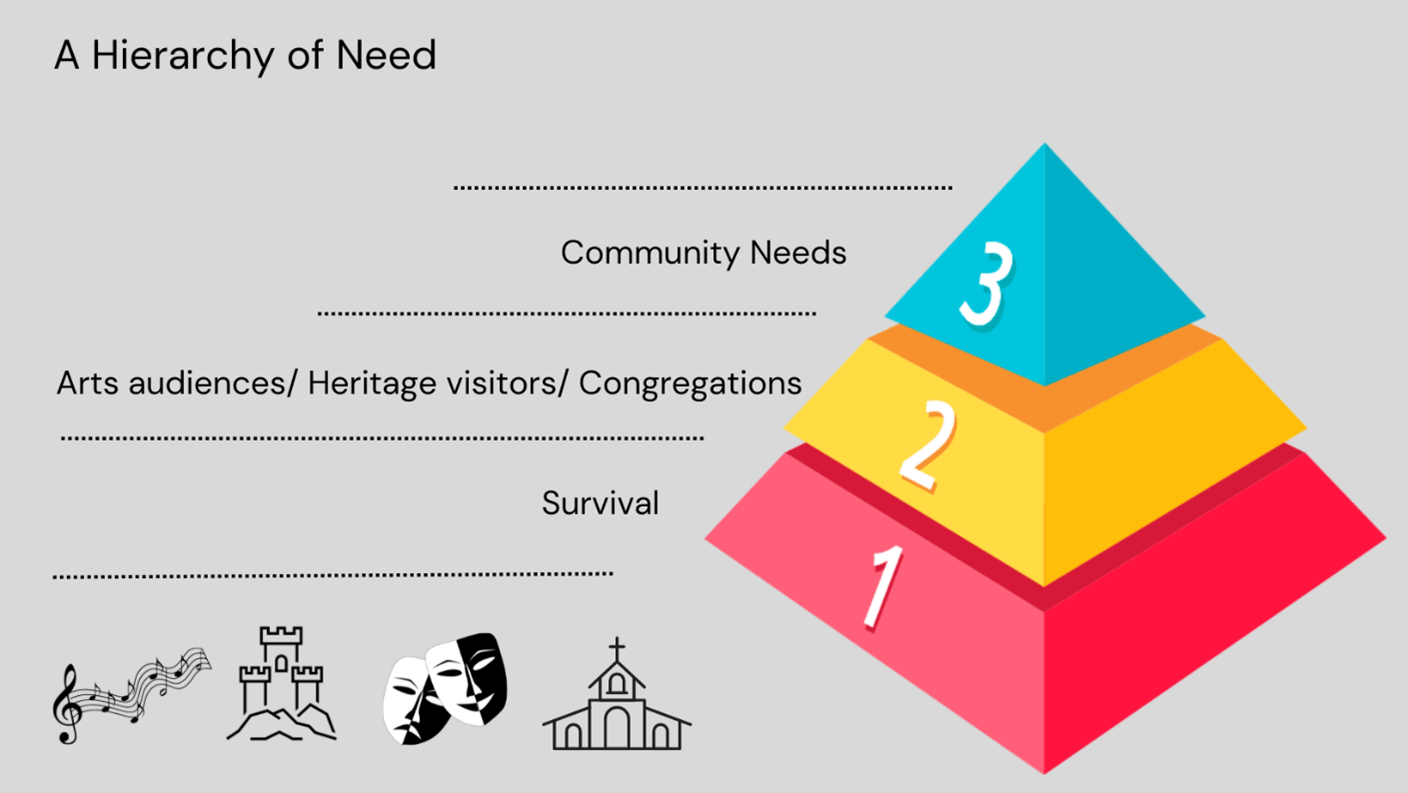Needs Must
Some of you may be familiar with the Hierarchy of Needs a motivational theory developed by American Psychologist Abraham Maslow (1908-1970). Maslow argued that human beings are motivated by a hierarchy of needs whereby, in our journey to fulfilment, some needs take precedence over others. In perhaps a rather clumsy comparison, I have realised that charitable fundraising has its own hierarchy of needs. Bear with me here, as I apply Maslow’s theory of human psychology to fundraising.
Having worked in both Performing Arts and Heritage fundraising, I realised that there are very clear parallels to be drawn between the two. Both sectors are reliant on contributed income that in many cases far outweighs their commercial income. Audiences tend to be small but with an extremely loyal core. Supporters/ audiences/ visitors are also donors. In recent years, both sectors have experienced decline in audience/ visitor numbers, which in turn was then accelerated by Covid. Since then, audience levels have still not returned to what they were before the pandemic. All these characteristics apply equally to heritage sites, ancient buildings, churches, orchestras, theatre companies or dance groups.
Need 1 – The charity’s survival
The predicament in which many of these charities find themselves makes them grasp for their first most basic need; Survival. It is an understandable reaction for an orchestra to agonise over how they are going to keep making music; how they will continue provide for the livelihoods of their musicians. Similarly, the trustees of an ancient building will be asking themselves where they’ll find the money to fix a leaking roof or a crumbling church spire. This basic survival need is ingrained in all of us and is (understandably perhaps) entirely self-serving. However, the objective of a charity can never be the survival of the charity itself. It’s a well-known conundrum in Heritage and Performing Arts fundraising.
Need 2 – Audiences / visitors / congregations
Maslow’s theory argues that needs lower down in the hierarchy must be satisfied before we can attend to needs higher up in the pyramid. Once a charity has achieved “safety”, or at least when they are no longer in immediate danger of collapse (they are very good at living on the breadline), their next aim is to satisfy their regular user’s needs. Regular users’ needs can include weekly Sunday worship for example, or the need to experience high-quality performances. This is another area where arts and heritage organisations are strikingly similar. Audiences in the arts tend to be surprisingly small and average congregations of parish churches in this country are even smaller. What they have in common is an extremely loyal core, which means a high degree of repeat attenders. An orchestra that gives 50 concerts a year for an average of 400 people, will tell you that their annual audience size is 20,000. But what if the same 400 people come back 50 times? It is exactly the same among church attenders and (to a lesser degree) heritage visitors.
Serving a small audience won’t help charities in their fundraising. Focusing on the audiences you already have may give you some short-term Individual Giving gains (as heritage visitors and arts audiences are often donors as well), but the larger grant makers like to see their money make an impact among a wide range of people. It means charities would be well advised to target the needs of those not already looked after. Would you invest a million pounds to restore an ancient parish church for the benefit of a congregation of a hundred?
Need 3 – People
The obvious answer is to address the needs of those who are NOT already part of your audience. What would they like to use your beautiful old building for? What kind of experience would they like to get out of your arts charity? The National Lottery Heritage Fund says that there is little point repairing an old building (however beautiful) if you’re not going to make it live; if you’re not going to give a wide range of people a reason and an opportunity to use it. Arts Council England, whilst using slightly different words, says exactly the same.
The larger grant makers always target the needs of communities; they rarely fund the Art or the Heritage itself. The dance, the drama, the music, the church or the heritage are merely vehicles to deliver the benefits that will address people’s needs. Remember this little pearl of fundraising wisdom: Funders give you their money because you meet needs, not because you have needs.
An experienced Heritage and/or Performing Arts consultant can help you develop your charity’s strategy towards a persuasive case. Case development is an important strategic instrument that will help identify the needs that sit at the top of the pyramid.
Helping yourself by helping others
Those charities that successfully address the top need, will find that the lower down needs will be met as well. In the process, those charities will become a more fundable proposition. I hesitate to use the phrase but it’s a “trickle down” model, where the money, once delivered to the top, comes cascading back down the pyramid. It’s a volcano of benefits. I better leave it there, before my metaphors get the better of me.
Gijs Elsen






